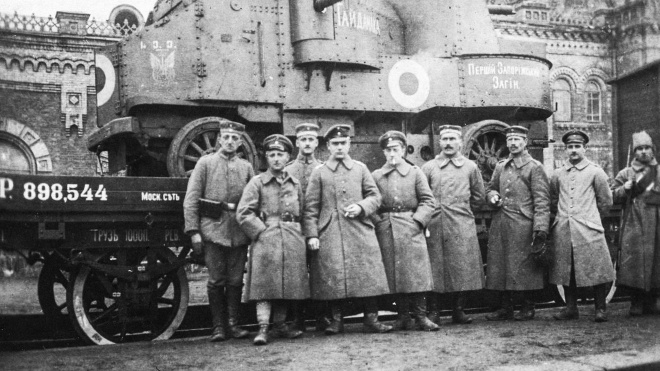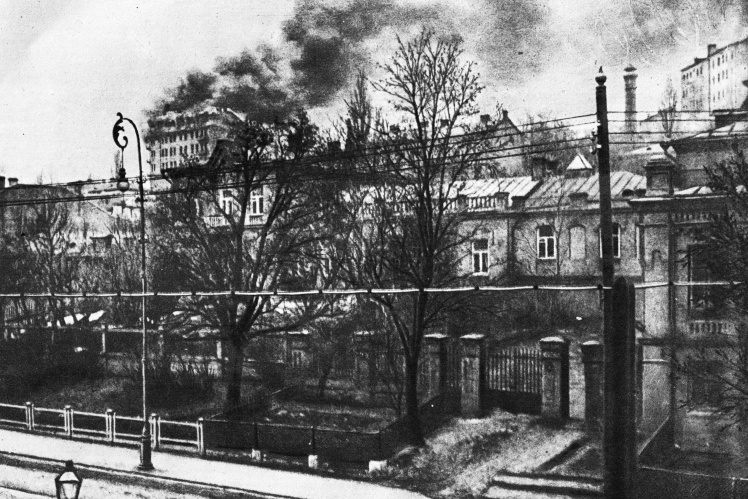At the beginning of 1918, the situation for the Ukrainian Peopleʼs Republic was really bad. The troops of Bolshevik Soviet Russia gradually occupied Ukrainian territories and broke through to Kyiv. At that time, negotiations between the countries of the Quadruple Union, the Bolsheviks and representatives of the Ukrainian Peopleʼs Republic continued in Brest.
In words, the Bolsheviks claimed the right to self-determination for all peoples who were part of the former Russian Empire. In fact, they dragged out the negotiations in Brest as much as they could, trying to establish Soviet power in Ukraine, Belarus and the Baltic states by force. At the beginning of February 1918, after several days of shelling Kyiv with heavy artillery, the Soviet troops captured the Ukrainian capital and terrorized it, killing several thousand citizens.
Bolshevik soldiers in occupied Kyiv, 1918. The burning house of the chairman of the Central Rada Mykhailo Hrushevskyi on Pankivska Street near the modern Shevchenko Park, February 7, 1918. During the storming of Kyiv, the Bolsheviks fired aimed fire at it.
Getty Images / «Babel'»; nmiu.org / «Бабель»
In such a situation, on February 9, 1918, the Ukrainian delegation in Brest managed to sign a peace agreement with Germany and Austria-Hungary following the results of the First World War. Moreover, on very decent terms: the parties renounced mutual claims and exchanged prisoners of war, the Ukrainian Peopleʼs Republic was recognized as an independent state and even additionally received the lands of the Kholm region, in return, Ukraine had to supply the Germans and Austrians with various goods, primarily food — bread, meat, sugar and other products. As for military aid, modern historians assume that the new allies initially "invited themselves to Ukraine." After all, the Ukrainian delegation in Brest did not have the authority to make such a decision. And only a few days later, the Ukrainian government made it official in order to save face. However, the Ukrainian Peopleʼs Republic had no particular choice — at that time, it would hardly have been able to liberate its territories from the Bolsheviks on its own.
Austro-Hungarian troops enter Kamianets-Podilskyi after the signing of the Brest Peace Treaty, 1918.
Wikimedia / «Бабель»
The Bolsheviks again tried to drag out the negotiations in Brest. But the Germans and Austrians got tired of it, and on February 18, 1918, their 450,000-strong army went on the offensive along the entire Eastern Front from the Baltic Sea to the Carpathians. The Bolshevik units fled to the east almost without fighting. Already at the beginning of March, German and Ukrainian units entered Kyiv, and at the beginning of April, they entered Kharkiv. At that moment, Donbas and Crimea remained to be recaptured from the Bolsheviks.
Everything was difficult with Crimea. When the Central Rada proclaimed the creation of the Ukrainian Peopleʼs Republic by the III Universal in November 1917, it did not include Crimea. In this way, Kyiv emphasized that it respects the right of the Crimean Tatars and other peoples to self-determination regarding the fate of the peninsula. But at the beginning of 1918, the political situation was completely different. In Crimea, as well as in Kyiv, the Bolsheviks seized power and also staged mass terror.
In January 1918, the Central Rada adopted a law on the fleet, according to which the entire Black Sea fleet — both commercial and military based in Sevastopol — was considered Ukrainian. And it would be impossible to establish control over the fleet without controlling Crimea. However, in the emergency conditions of the negotiations in Brest, the Ukrainian delegation did not begin to declare claims to Crimea. Therefore, the Germans themselves were not against capturing the peninsula together with a considerable fleet, which would definitely be useful for them during the First World War. So, having pushed back the Bolshevik units on mainland Ukraine almost without a fight, the German troops began to prepare an invasion of Crimea with the expectation of the same blitzkrieg. General Robert von Kochʼs shock group, consisting of two divisions and several auxiliary regiments, had to accomplish this task.
Battleships of the Black Sea Fleet in the Southern Bay of Sevastopol, 1918.
Wikimedia / «Бабель»
Then the UNR leadership decided to overtake the Germans. On April 10, 1918, the military Minister Oleksandr Zhukovsky set a secret task for the commander of the Zaporizhzhya Division, Oleksandr Natiyev, to send the most combat-capable units to the Crimea, reach Sevastopol, and take control of the Black Sea Fleet. Natiyev quickly formed a strike group headed by one of his most outstanding commanders, Lieutenant Colonel Petro Bolbochan. The group included about nine thousand soldiers: infantry, cavalry, an artillery unit, armored vehicles, and two armored trains. Already on April 13, these troops advanced from the Kharkiv region to the south.
Commander of the Zaporizhzhia Army Corps of the Ukrainian Peopleʼs Republic Oleksandr Natiyev (center) and head of the Crimean operation Petro Bolbochan (right), 1918.
Wikimedia / «Бабель»
In mid-April 1918, two military groups approached the Crimea. The Germans were preparing to storm the peninsula from the northwest, through Perekop Isthmus. And Ukrainians — from the northeast, through Chongar. The Bolshevik forces in Crimea at that time did not exceed 20,000 people. However, they were scattered: some covered cities, railway hubs and ports, some fought with the Crimean rebels, and the most combat-ready units, about five thousand, stood in Perekop and Chongar.
Later, a kind of head-to-head competition began between the Ukrainians and the Germans. At first, the initiative was taken by the Germans. Already on April 18, they broke through the defense of Perekop, and at that time Bolbochanʼs group was still advancing with battles in the Melitopol area. Advanced Ukrainian units approached the Chongar Bridge on April 21. Scouts discovered that the Bolsheviks managed to mine the bridge, and around it they set up fortifications with machine guns and cannons. Bolbochanʼs original plan was to storm the crossing by landing on boats that had already been quickly brought up by rail. But the enemy could blow up the bridge. This would jeopardize the entire operation, because in this case it would definitely be impossible to catch up with the Germans.
Then Bolbochan went for a tactical trick. On the night of April 22, about 20 Ukrainian scouts rode swiftly across the bridge and caught the Bolshevik guards by surprise, preventing them from detonating the explosives. Two armored trains followed them, and infantry and artillery went under their cover. Already in the morning it was possible to break through the defense.
Armored train "Sichovy strilets" of the UNR army, 1918.
Wikimedia / «Бабель»
In the evening of the same April 22, Bolbochan approached Dzhankoy city, an important railway hub. However, the German vanguard had already entered the city. The Germans were waiting for the approach of the main forces and the command in order to decide what to do next: whether to pursue the Bolshevik units that were fleeing towards Feodosia, or to detain the Ukrainians, who came from an unknown place.
But Bolbochan did not wait. Now he seized the initiative from the Germans and quickly moved by railway to Simferopol. Already on April 23, he defeated the Bolsheviks near Sarabuz. And on the morning of the 24th, he entered Simferopol, ahead of the Germans by at least a few hours. The operation unfolded rapidly, on April 25, the advanced units of the Ukrainian cavalry entered Bakhchisarai, and then went along the mountain paths towards Sevastopol.
The Germans, of course, did not like such a scenario. For some reason, the local population, especially the Crimean Tatars, gladly welcomed the Ukrainian troops and willingly signed up as volunteers for Bolbochanʼs detachment. So on April 25, General Robert von Kosch ordered to surround the Ukrainian units in Simferopol and began to figure out what was going on. The Germansʼ claims to the Ukrainians sounded something like this: we donʼt know who you are, so either show us the document on the basis of which you conduct military operations in Crimea, or lay down your weapons and get out of here under our escort.
Commander of the German military group in the Crimea, General Robert von Kosch, photo of 1915. Petro Bolbochan during the First World War.
Wikimedia / «Бабель»
Bolbochan did not have a written order, but he refused to lay down his weapons. Von Kosh, for his part, wanted to avoid an armed conflict, so he suggested contacting the military ministry of UNR in Kyiv. But it only got worse. The Ukrainian leadership replied to the Germans that they did not know anything, that no orders were given and that there were no Ukrainian units on the peninsula. And Bolbochan was told by Kyiv something like "hold on, Ukraine will not forget you." The situation threatened to turn into a direct combat between yesterdayʼs allies. Bolbochan even developed several plans for a breakthrough: either through the mountains to Sevastopol, or to the Kerch Peninsula, where he could hope for help from the Kuban.
Finally, the Ukrainian government made a decision. On April 27, Bolbochan received an order from the Minister of Defense Oleksandr Zhukovsky to leave Crimea. And General von Kosch was informed from Kyiv that the previous statements about the absence of Ukrainian units on the peninsula were simply a misunderstanding.
Thus, the Ukrainian troops, without suffering a single defeat, were forced to leave Crimea due to a political decision. The main goal of the campaign was achieved to some extent. On April 29, the leadership of the Black Sea Fleet raised Ukrainian flags, waiting for the arrival of Bolbochanʼs group. Although the Germans captured Sevastopol, they were unable to completely subdue the fleet.
For the UNR government, the political defeat in Crimea had even more serious consequences. In just a few days, on April 29, General Pavlo Skoropadsky, with the connivance of the German command, staged a coup in Kyiv, seized power and dissolved the Central Rada, current Ukrainian Parliament.
Hetman Pavlo Skoropadsky with German generals, September 9, 1918.
Getty Images / «Babel'»
Translated from Ukrainian by Anton Semyzhenko.
We believe that this time the Ukrainian military will enter Crimea without any political obstacles, and your donations will enter Babelʼs accounts: 🔸 in hryvnia 🔸 in cryptocurrency 🔸 via Patreon 🔸 or PayPal: [email protected].





